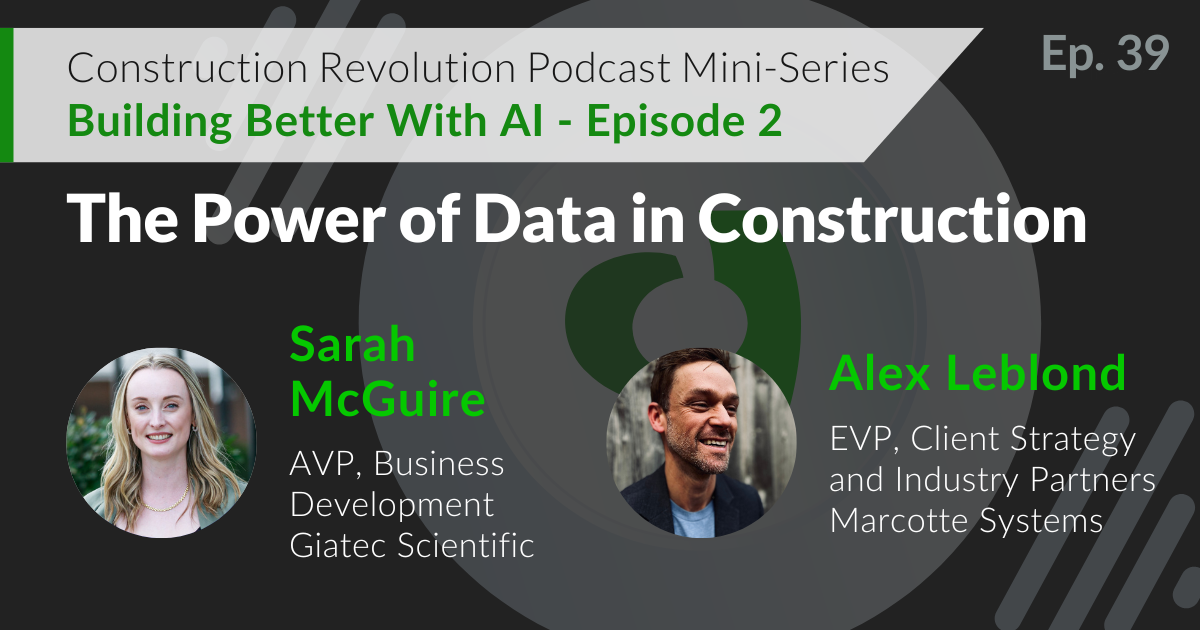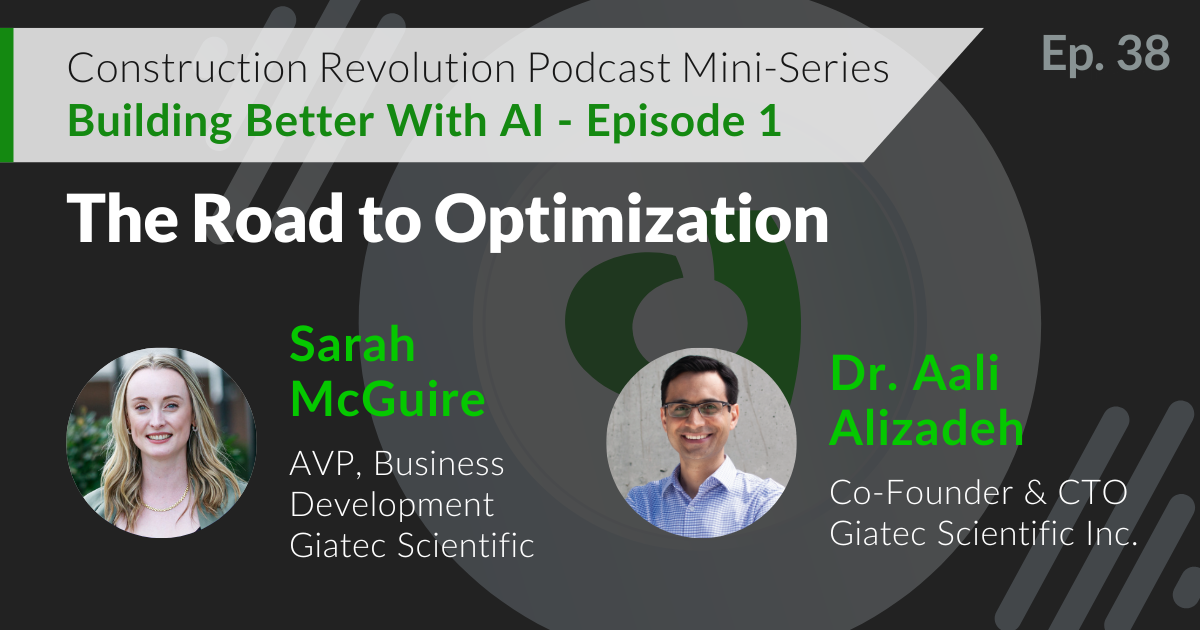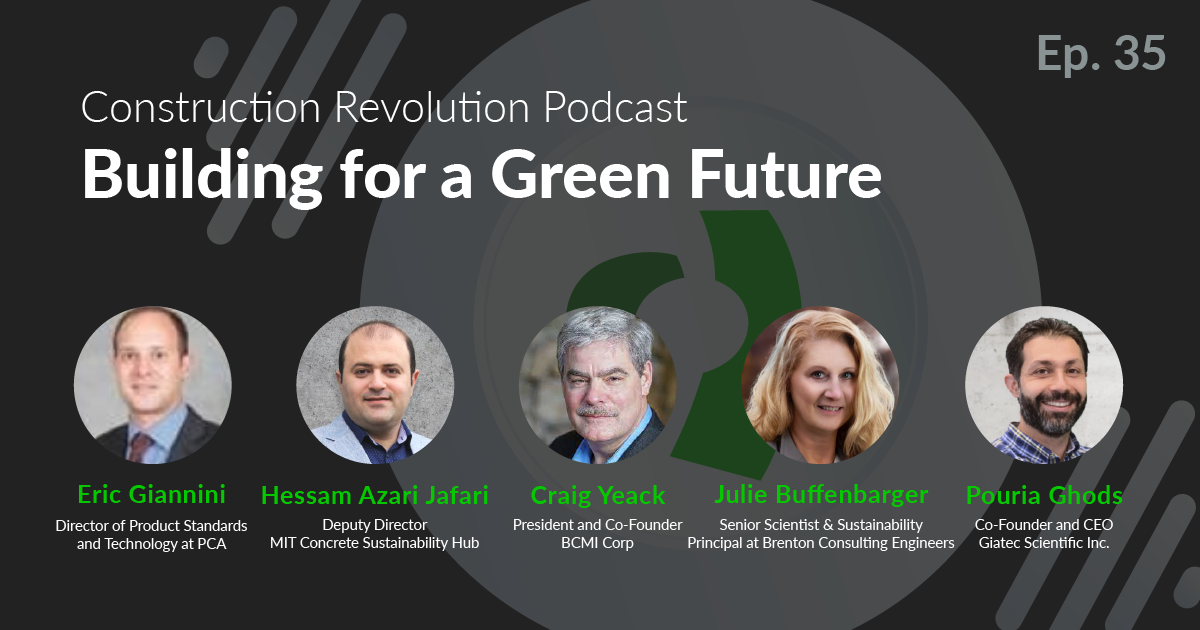
Episode 7 |
April 13, 2021
EPD and Sustainability in Construction
In This Episode
In this episode of The Construction Revolution, we are joined by Stacy Smedley, Director of Sustainability at Skanska USA, and Executive Director at Building Transparency. She talks about environmental product declaration (EPD) in the construction industry and the development of the Embodied Carbon in Construction Calculator (EC3) tool. Stacy also touches on the future of sustainability in construction as well as the current path to eliminating embodied carbon from buildings!

Host
ERIC YEE
Content Marketing Manager, Giatec Scientific Inc.
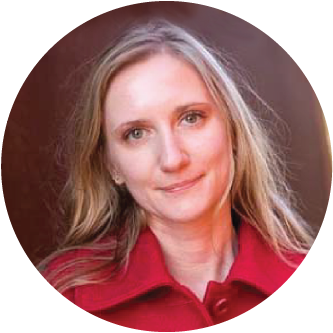
Guest
STACY SMEDLEY
Director of Sustainability at Skanska USA, and Executive Director at Building Transparency.
Podcast Transcript
Eric:
Prior to joining the construction space, I had no idea what an environmental product declaration or EPD was. But from my limited understanding, it essentially acts like a label, similar like a nutritional label on food or even those energy star ratings. But it’s more about how much greenhouse gas emissions a product is responsible for in getting it to the final person. Could you just touch on what makes up an EPD in the construction space?
Stacy:
Sure, yeah. You’ve got it right. An environmental product declaration, the analogy I always use is it’s an environmental impact nutrition label for a building material. It’s got a declared unit, which is like a serving size. For concrete, it might be a cubic yard, one cubic yard of concrete, instead of a two thirds of a cup or something like on a food item. Then, there’s a kilogram of CO2 equivalent, which is basically the global warming potential associated with creating that one cubic yard of concrete. That’s really looking at the carbon emissions and the gases that are being released and getting to amount of that per cubic yard of concrete so that if you wanted to, you could start to analyze products that are comparable, like two concrete mixes from two suppliers on that metric, to understand which one has a lower impact.
Eric:
I guess, if you’re a general contractor or an owner and you’re really interested in the potential impact that your choices are making in building materials, that calculator that you’ve created, the EC3 calculator is a really great way to compare one-to-one which would have a better impact on your building.
Stacy:
Yeah. What we’ve done with the EC3 tool suite, we found the CPDs, and we found that they’re third-party verified, first of all, so they’re not self-declared. They go through a verification process by a third party outside of the manufacturer. We also have rules that are set up to follow ISO standards, so they’re set on rules that help to align materials that are in the same category. There were these PDF documents, the program operators like UL or ASDM would publish to a website, and then someone like me and my scan SQRL, it’s digital contractor, would go find the PDF and download it, and then find the table that had that kilogram of CO2 per unit on page, like, 10 and it would take me an hour to find one EPD with that number that I then put in a spreadsheet, and I’d go find the next one so I could start to look at these manufacturers and products next to each other.
EC3 was the result of that acknowledgement of the time it was taking and that I wasn’t the only one that was out there doing that same thing of finding the PDF and downloading it and searching and creating spreadsheets. We took the time to digitize all of those EPDs. We’ve machine-read through scripts all of the data out of the PDFs, put it in a digital format, that then, that standard then allows someone to go in and pick concrete or rebar or gypsum board, go into that category, search by location if they want to see what’s available within a certain region or place, set performance characteristics for that material, then click search and it’ll populate your search with all of the EPDs that we’ve digitized that meet your criteria.
Putting something in like gypsum board, which is something that we use across all sorts of different building types, I’ve got it right here on my wall. You could put in gypsum board and click search for U.S. manufacturers and get certain feeds in the USGS and their products, and then be able to say, “Okay, both of these meet my criteria, but this one’s lower carbon, so I should probably use that one because it’s just a better choice and it’s available to me right now.” That’s the first low-hanging fruit step.
Eric:
One of my follow-up questions was going to be, how did the EC3 calculator get started? I’m assuming it clearly got started from, there must be a better way to do this, and looking through all these PDFs that are probably formatted differently and then you’re probably thinking, “Okay, well, if I’m doing this, how many other organizations that’s extrapolating that or spend the same amount of time doing this. There must be a better way.
Stacy:
Correct. I think when that kind of idea and that realization came to me at Skanska with our team, it was, “Okay if we’re going to solve it for ourselves, why don’t we just solve it for everybody and make sure this is a free open access resource.” That’s what we did. By doing that, we got other funding that came in to help support its creation, folks like Microsoft and some other large companies. Skanska kept on supporting it. We got webCoRE, another contractor. It got this kind of groundswell behind it because it was going to be free for everybody. Then, we launched it in November of 2019 as a free tool.
Eric:
I mean, it just makes sense because if you’re already experiencing that and you’re going through the process of looking for this information to make better decisions, because you care about the impact in the environment and the legacy that you’re leaving, why would you not enable other people to do the same thing? So that makes a lot of sense. There’s another part of the calculator, too. It’s not just necessarily looking things up, but you can also take your plans and put them in them to see what kind of overall impact you’re going to have, correct?
Stacy:
Correct, yeah. There’s really two parts. The first is that kind of search where you can just go in and easily get to a product level search if you’re interested in specifying something quickly or just understanding that. But then you can also … If you think about it kind of like cost estimating for construction. You have a bill of materials with quantities, and you take a cost per unit of material and do the multiplication to get to an overall cost of each material category or choice. It’s the same thing where you can just input your material quantities and then the tool does the math of the carbon per unit for you to give you a look of here’s my concrete versus my steel versus my interior materials and how big the impact is from a carbon perspective. Then, here’s what happens if I actually choose these projects, these products in terms of where I fall against what’s possible. Then, it reported out result where you can get to like a kilogram of CO2 per square foot for your project.
Eric:
That makes it so much easier. I can just imagine if they didn’t have this calculator, how daunting it might be to actually try to figure all of that out on your own.
Stacy:
It’s a lot of spreadsheets and calculations in Excel.
Eric:
I like spreadsheets, but not everyone likes them. I’m curious, what has the reception been to it from material manufacturers? Are most of them interested in for it or some people maybe resistant to disclose what their carbon emissions on their product, or maybe they’re just kind of nervous to actually have the visibility on those things?
Stacy:
It’s an interesting, it’s a mixed bag. Typically, in the sustainability space in the building industry, manufacturers and suppliers are looking for the business case to do anything, something that’s going to help them get selected and help increase what they’re selling. We’ve seen that with things like toxicity, disclosure, VOC content, or some of the other things that have been pushed through rating systems like lead, where once people started asking for it, they, of course, we’re going to provide it because it was something that could differentiate them or even just meet a criteria that was required. The same thing is happening with EPDs where there were some suppliers that were looking into their carbon impacts and saw an early value and being the first to disclose, or they were doing it anyway so why not publish an EPD to show what they were doing.
There are others that were just doing it because it was a checkbox. There was a lead credit that just said provide 20 EPDs for 20 products that you’re building with. A lot of the first kind of EPDs were created just because someone said, “I just need your EPD.” They weren’t looking at the data to do anything with it. So, we do have a good collection just based on that.
Now, what’s happening is that market demand where now that the data is available for those that have publicly disclosed and already invested, there’s a competition among those that have disclosed on how can we continue to optimize our products from a carbon perspective. Then, there’s kind of a business case, almost requirement for those who haven’t, to stay competitive they need to actually invest and get the environmental product declarations, maybe even to be allowed to bid on a job.
That’s where it’s going. I think there’s policy and owners now that are going to say, “Hey, I can look. I have three choices for this. Those are the three that can actually bid on my job.” Or there might be legislation that comes, that says, “You have to have an EPD for this category to be procured federally.” So, I think those who are a little bit late on that business case or that haven’t had that business case yet, can be brought along based on some of these policies that are coming.
Eric:
It seems like based on the limited trends I see is if you’re not doing these, your pool of potential customers is slowly going to shrink over time where it makes sense just to do them, to make yourself more competitive, so you have that market to go through.
Stacy:
Also, the positive thing, I think, about more suppliers starting to do it is also that they learn more about their emissions and their impacts by going through the process of getting the life cycle assessment done of their material or their product, understanding their emissions at the plant level or back in their supply chain even, like where are they sourcing the stuff that goes into their products. That education on that side then allows them to start optimizing. There’s a big potential that this is going to start to really educate the larger manufacturing market on, gosh, I do have these impacts. I can actually reduce them. Some of those reductions may not be that costly. We just haven’t been looking at it.
Eric:
I mean, if you’re not measuring it, there’s no way to even know what needs to be fixed for sure. If there’s a manufacturer listening to this who wants to get started on producing an EPD, but they don’t know where to get started, what would you tell them to start with?
Stacy:
There’s a group of program operators here in the States, there’s a group that typically do EPDs in the U.S. or the North American region for different material categories. Actually, an EC3, if you log in to the tool on the left, there’s a “How to get an EPD” section on the left where if you click on your product category, it will give you the list of program operators that have done EPDs for your category and how many. You can start to understand who you could reach out to and say, “Hey, I’m interested in this. You provide this for my material category. What’s the process?” Really, it’s engaging the program operators that are able to do the verification and they’ll help you get started and connect you to who needs to do that kind of life cycle assessment work. I think that’s really the starting point is just to kind of understand who can provide the service and start to reach out to them and ask questions.
Eric:
Well, it’s good to know that there’s someone out there that can help manufacturers with that, just so that they’re not going in alone and trying to figure that out.
Stacy:
Also, Building Transparency hosts a group called the Materials CAN, which is Materials Carbon Action Network, which is a group of manufacturers across different material categories. They’re ones that have been doing this for some time now, kind of the early adopters. That group’s sole focus is educating and support of the larger manufacturing community. That’s on our website too and we’re always looking for new members or new manufacturers that we can help and that’d be a peer to peer. It would be someone that’s done this process as a manufacturer that wants to help a new one understand it too.
Eric:
Some of that’s been through, or that is a little bit down the road before the new person. That’s great. I added in these questions because I know a lot of the EPDs, they seem like a very like business-to-business kind of information. Do you see any consumers who are environmentally focused looking into them when choosing maybe where to live or where to have their office, like in terms of buildings? I can see if there were these on product labels, you could easily make that choice. I can see where owners are having that decision-making. But do you think consumers or end users of these buildings are going to eventually have any impact on looking for EPDs or anything like that?
Stacy:
I think that, yes, I think so. I think similar to how, I think, we’ve gotten used to looking for lead plaques or as a building lead certified right now, in terms of, I think there are some tenants and some leasers of building space that require that type of thing now. They want to be in a building that’s green, or that’s doing better. There’s also a zero-carbon certification that you can get now. I think as people start to understand more, just that the scale of the impact of all these building materials and these emissions, but it may come to the point where it’s going to be like, “Oh, how low carbon is this building?” What is your kilogram of CO2 per square foot? Or can that be a metric that’s planted on the side and the QR code or displayed somewhere. We’re talking about the EC3 tool already creates QR codes at the product level for each EPD, so the manufacturer wanted to just slap the QR code on their product. If someone scanned it, it would get them to that data.
Eric:
That is a very simple way to just quickly figure that out. Scan it and there you go.
Stacy:
Well, yeah, hopefully. I mean, that’s why we built that in because we want that to happen.
Eric:
I have one last question before I let you go, Stacy, and it’s actually maybe just pivoting a bit to your work on the carbon leadership forum. What’s the current path to eliminating embodied carbon from buildings look like from where we are now to what you hope to see in the future? What kind of technology are you kind of seeing?
Stacy:
Yeah, sure. There are different stages. Right now, we’re at this kind of low-hanging fruit stage where just by understanding the current supply chain, there’s around a 30% reduction possible just by making smart choices based on materials that already exist. That’s the first phase. While we’re doing that, what we’re seeing happen now, of course, through the data being out there is this competition and these manufacturers beginning to innovate to lower further. That next stage is just innovation and there’s kind of stages of innovation. There’s how do I optimize my plans from an energy perspective? How do I use recycled materials versus not? Those are all things to get to the next chunk, which might be another 20% or so. Now we’re down to about 50% or more from where we started. Well, that’s all happening.
There are also investments happening from the leading companies across different material categories on how do we get to zero. We want to be the ones that are there first. Examples are things like in the concrete and cement industry, carbon capture. Can we capture the carbon off the cement stack and either store it in a decommissioned oil well, or turn that CO2 into something liquified that could be used for something else? Those investments in those kinds of innovation case studies are already happening and that’s how we’re going to get to that bottom chunk.
What I’m hearing now when I talk to suppliers and manufacturers is we’re investing in the innovation so that when we need to actually implement these things in our plans, it’s just part of our annual plant budget. The cost to the consumer, it might not need to be 30%. It might be small or nothing because they’re building up the capacity to have that as part of their process. How long that takes, I don’t know. It’s moving way quicker than I thought it would already in terms of just people starting to look at this.
Eric:
That’s encouraging.
Stacy:
But I think if we’re talking about 2045, I’m fairly optimistic that we can, in 24 years we’ll be able to be getting pretty close to zero, if not zero. Then, there’s all these cool products coming online that are carbon sequestering bio-based products that are alternative products that are also seeing investment that might actually take us negative, where they’re storing the carbon or buildings could become carbon sinks and the carbon leadership forum is really doing a lot of research work around that.
Eric:
Within the concrete of the structure or some other ways, some other place in the building, they’d actually be storing carbon instead of releasing it into the atmosphere?
Stacy:
Yeah.
Eric:
That’s incredible.
Stacy:
That’s really the end game in my book.
Eric:
Well, especially when they talk about, there’s so much talk about how buildings are such a huge contributor, not just in being built but when they’re operating, but there’s a way to actually turn them into giant silos for carbon. That’s a very interesting proposition.
Stacy:
I agree.
Eric:
I just had to say, when you said that 2045 is only 24 years away, that was a little scary. It’s going to be here, but can it be not necessarily just from an aging perspective is what I’m thinking.
Stacy:
Yep. No, I agree. I hear you. I just turned 40 so I feel that.
Eric:
Well, Stacy, thank you so much for coming on the show today. I really appreciate your time. Where can people find out more information about the EC2 calculator?
Stacy:
If you go to the non-profit website, justbuildingtransparency.org, there’s a link to just register for free and gain access to the tool in five minutes yourself, and also some resources and videos that we’re developing and other kind of primer documents you can download.
Eric:
Perfect. Thank you so much. And thank you again, Stacy, for coming on.
Stacy:
Of course. Thank you.
Other Related Episodes
Episode 39 |
April 4, 2024
The Power of Data in Construction
In the second episode of our “Building Better with AI” mini-series, host Sarah McGuire explores “The Power of Data in Construction” with Alex Leblond, EVP Client Strategy and Industry Partners of Marcotte. Join Sarah and Alex as they delve into the dynamic world of construction data, unravelling the complexities of on-premises systems and shedding light on the industry’s journey toward technological advancement. Gain valuable insights into the challenges of acquiring and processing data and discover how innovative solutions are reshaping traditional practices. Guided by Alex’s extensive experience at Marcotte, this episode offers a comprehensive exploration of the past, present, and future of data in construction. From discussing the evolution of batching systems to the transformative potential of AI, this conversation delves into the pivotal role of data in driving efficiency, sustainability, and profitability. Don’t miss this enlightening episode as we continue our mission to build better with AI!
PLAY
Episode 38 |
March 21, 2024
In this thrilling debut episode of our “Building Better with AI” mini-series, dive into the dynamic world of concrete innovation with the visionary Co-Founder and CTO of Giatec, Aali Alizadeh, Ph.D. Dr. Alizadeh shares captivating insights into the challenges facing the concrete industry and how Giatec® SmartMix™ offers transformative solutions. From tackling overdesign to breaking down data silos, discover how SmartMix is reshaping concrete management practices with its cutting-edge AI technology. Join host Sarah McGuire as she delves into the narrative behind SmartMix’s groundbreaking journey, uncovering its revolutionary impact on concrete mix management and optimization. This is just the beginning! Stay tuned for exciting insights into the future of construction as we tease upcoming episodes that promise to push the boundaries of innovation even further. Listen in now and join us as we embark on a thrilling journey to build better with AI! Ready to unlock your concrete advantage? Learn more about SmartMix.
PLAY
Episode 35 |
January 2, 2024
In this episode of The Construction Revolution Podcast, you’ll hear from construction industry experts as they explore the future of green construction and share their vision for a more sustainable built environment. This panel discussion was originally recorded in March 2023, at the Net Zero Construction Conference. To hear more insightful conversations like this one, don’t miss the 2024 Net Zero Construction Conference. Stay up to date with announcements about the conference by following the Net Zero Construction Conference on LinkedIn or by signing up for the newsletter on the Net Zero Construction Conference website.
PLAY
Want to Be a Guest Speaker, Sponsor, or Just Have a Question for Us? Fill In the Form!

